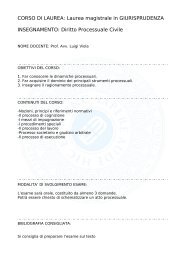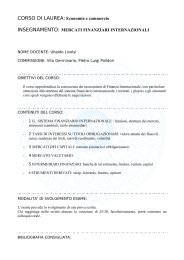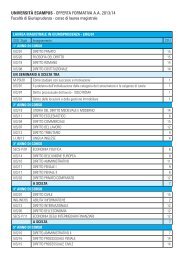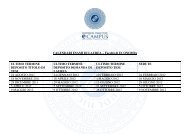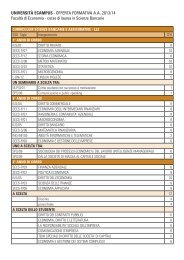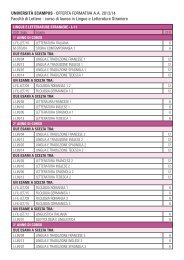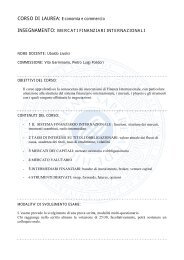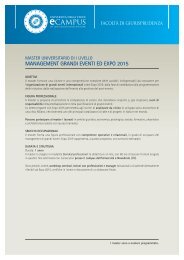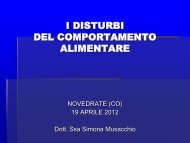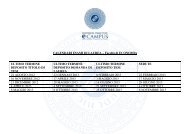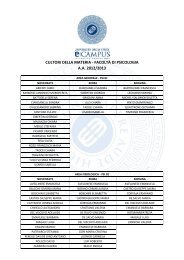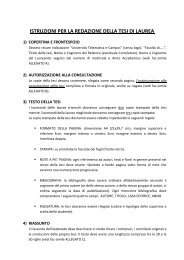estratti nutraceutici standardizzati ed energia da tessuti ... - eCampus
estratti nutraceutici standardizzati ed energia da tessuti ... - eCampus
estratti nutraceutici standardizzati ed energia da tessuti ... - eCampus
Create successful ePaper yourself
Turn your PDF publications into a flip-book with our unique Google optimized e-Paper software.
then concentrate by two different Heat-Pump evaporators, and, if necessary, finally r<strong>ed</strong>uc<strong>ed</strong> to microniz<strong>ed</strong>powder. After an initial step of dynamic pre-maceration, the process is applicable on green and dri<strong>ed</strong>vegetal tissues. With this proc<strong>ed</strong>ure it is possible to obtain concentrat<strong>ed</strong> or semi-solid solutions (20-30%residual water) and powders stan<strong>da</strong>rdiz<strong>ed</strong> in polyphenol content, with a high biological value, suitable forfood, cosmetic and pharmaceutical industries. The title in bioactive components of Cynara, as an example,was express<strong>ed</strong> by HPLC / DAD / MS monitoring two subclasses of polyphenolic compounds (mono- and dicaffeoylquiniciesters and flavonoids). The post-extraction residue, depending upon the us<strong>ed</strong> biomass, can beemploy<strong>ed</strong> for animal fe<strong>ed</strong>ing, agricultural and agro-industrial products or subject<strong>ed</strong> to an anaerobicdigestion process for the production of biogas and energy. Through the use of concentrat<strong>ed</strong> solutions andpastes or powders, bak<strong>ed</strong> foods, naturally stabiliz<strong>ed</strong>, or enhanc<strong>ed</strong> products, cosmetics and supplements, formodulation and cholesterol/triglycerides r<strong>ed</strong>uction in humans, are design<strong>ed</strong> and market<strong>ed</strong>.BibliografiaBruni A. (1999) Farmacognosia generale e applicata. I farmaci naturali. (<strong>ed</strong>. Piccin), pp 294-295.Coinu R., Carta S., Urgeghe P. P., Mulinacci N., Pinelli P., Franconi F., Romani A. “Dose–Effect study onthe antioxi<strong>da</strong>nt properties of leaves and outer bracts of extracts obtain<strong>ed</strong> from Violetto di Toscanaartichoke”, Food Chemistry, 101, 524-531, 2007.Dogan S et al., Journal of Agricultural and Food Chemistry, 53, 776-785, 2005.Gebhardt R (1997) Antioxi<strong>da</strong>tive and protective properties of extracts from leaves of artichoke (Cynarascolymus L.) against hydroperoxide induc<strong>ed</strong> oxi<strong>da</strong>tive stress in cultur<strong>ed</strong> rat hepatocytes. Toxicol .Appl.Pharmacol. 144: pp 279-286.Gebhardt, R. “Inhibition of cholesterol biosynthesis in primary cultur<strong>ed</strong> rat hepatocytes by artichoke (Cynarascolymus L.) extracts”. Journal of Pharmacology and Experimental Therapeutics, 287, 1122-1128, 1998.Lattanzio V., Vanadio S., Taranto G. “Distribuzione di composti ortodifenolici in <strong>estratti</strong> di differenti partidel carciofo”, Ind. Conserve, 53, pp 29-33, 1978.PCT/IT2008/000135, <strong>da</strong>ta di deposito 01/04/08. Pizzichini M., Romani A., Pizzichini D., Russo C., PinelliP. “Process for producing refin<strong>ed</strong> nutraceutic extracts from artichoke waste and from other plants of theCynara genus”.PCT/IT2009000246, <strong>da</strong>ta di deposito 05/06/09.RACE s.r.l. “Integrat<strong>ed</strong> process for recovery of a polyphenolfraction and anaerobic digestion of olive mill wastes”.Pinelli P., Agostini F., Comino C., Lanteri S., Portis E., Romani A. “Polyphenolic Composition of Wild andCultivat<strong>ed</strong> Cardoon Leaves”, Food Chemistry, 105 (4): 1695-1701, 2007.Preziosi P. Il Farmaco (Ed. Sc.), 17, 701-745, 1962.Slanina J, et al. Cesko-SloV Farm, 42, 265-268, 1993.Slanina J., Taborska E., Bochorakova H. et al. ”New and facile method of preparation of the anti-HIV-1agent, 1,3-dicaffeoylquinic acid”. Tetrah<strong>ed</strong>ron Letters, 42 (19), 3383-3385, 2001.Wang M.F., Simon J.E., Aviles I.F., He K., Zheng Q.Y., Tadmor Y. “Analysis of antioxi<strong>da</strong>tive phenoliccompounds in artichoke (Cynara scolymus L.)”. Journal of Agricultural and Food Chemistry 51 (3), 601-608, 2003.Zhu XF. et al., Fitoterapia, 76: 108–111, 2005.8



